2006 BMW M3 COUPE winter tires
[x] Cancel search: winter tiresPage 115 of 170

115
Those grades represent the tire's ability
to stop on wet pavement as measured
under controlled conditions on speci-
fied government test surfaces of
asphalt and concrete. A tire marked C
may have poor traction performance.
The traction grade assigned to
this tire is based on straight-
ahead braking traction tests, and does
not include acceleration, cornering,
hydroplaning, or peak traction charac-
teristics.
tire's resistance to the generation of
heat and its ability to dissipate heat
when tested under controlled condi-
tions on a specified indoor laboratory
test wheel.
Sustained high temperature can cause
the material of the tire to degenerate
and reduce tire life, and excessive tem-
perature can lead to sudden tire failure.
The grade C corresponds to a level of
performance which all passenger car
tires must meet under the Federal
Motor Vehicle Safety Standard No. 109.
Grades B and A represent higher levels
of performance on the laboratory test
wheel than the minimum required by
law.
The temperature grade for this tire
is established for a tire that is
properly inflated and not overloaded.
Excessive speed, under-inflation, or
excessive loading, either separately or
in combination, can cause heat buildup
and possible tire failure.
summer tires.
Tire conditionWheel/tire damageInspect your tires frequently for signs of
damage, foreign objects and tread
wear, and check tread depth.
Due to low-profile tires, please
note that wheels, tires and sus-
pension parts are more susceptible to
road hazard and consequential dam-
ages.
Unusual vibrations encountered during
normal vehicle operation can indicate
tire failure or some other vehicle defect.
This type of problem can be caused by
contact with curbs, etc. This is also true
for irregularities in the vehicle's han-
dling characteristics, such as a pro-
nounced tendency to pull to the left or
right.
Should this occur, respond by immedi-
ately reducing your speed. Proceed
carefully to the nearest BMW center or
professional tire center, or have the
vehicle towed there. Tire damage, up to
and including blowouts, can endanger
the lives of both the vehicle occupants
and other road users.<
Tire code
OverviewControlsMaintenanceRepairsDataIndex
Page 116 of 170
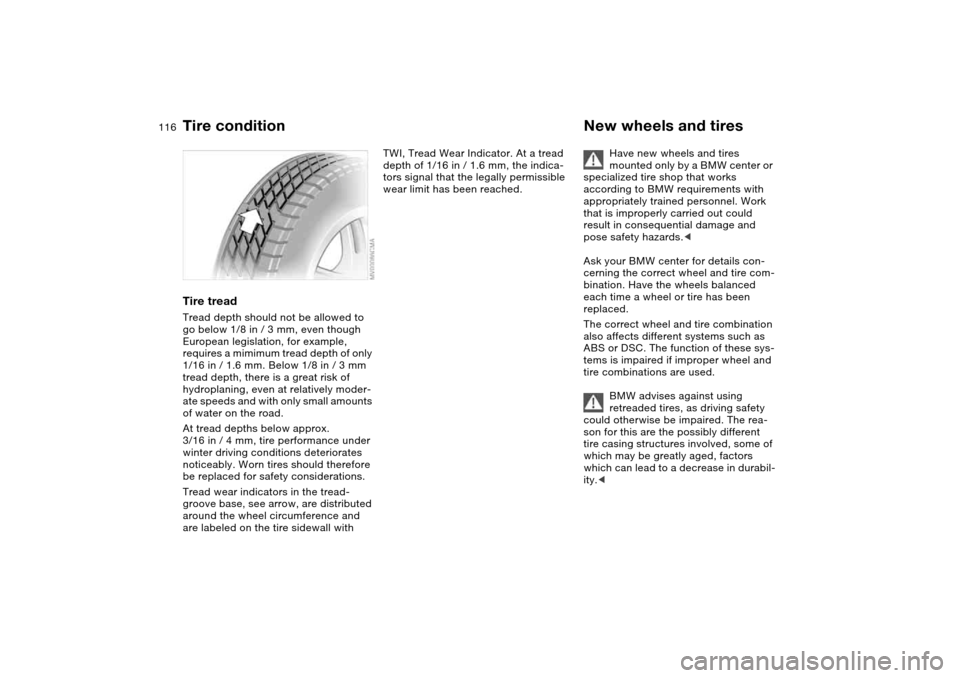
116
Tire treadTread depth should not be allowed to
go below 1/8 in / 3 mm, even though
European legislation, for example,
requires a mimimum tread depth of only
1/16 in / 1.6 mm. Below 1/8 in / 3 mm
tread depth, there is a great risk of
hydroplaning, even at relatively moder-
ate speeds and with only small amounts
of water on the road.
At tread depths below approx.
3/16 in / 4 mm, tire performance under
winter driving conditions deteriorates
noticeably. Worn tires should therefore
be replaced for safety considerations.
Tread wear indicators in the tread-
groove base, see arrow, are distributed
around the wheel circumference and
are labeled on the tire sidewall with
TWI, Tread Wear Indicator. At a tread
depth of 1/16 in / 1.6 mm, the indica-
tors signal that the legally permissible
wear limit has been reached.
New wheels and tires
Have new wheels and tires
mounted only by a BMW center or
specialized tire shop that works
according to BMW requirements with
appropriately trained personnel. Work
that is improperly carried out could
result in consequential damage and
pose safety hazards.<
Ask your BMW center for details con-
cerning the correct wheel and tire com-
bination. Have the wheels balanced
each time a wheel or tire has been
replaced.
The correct wheel and tire combination
also affects different systems such as
ABS or DSC. The function of these sys-
tems is impaired if improper wheel and
tire combinations are used.
BMW advises against using
retreaded tires, as driving safety
could otherwise be impaired. The rea-
son for this are the possibly different
tire casing structures involved, some of
which may be greatly aged, factors
which can lead to a decrease in durabil-
ity.<
Tire condition
Page 117 of 170
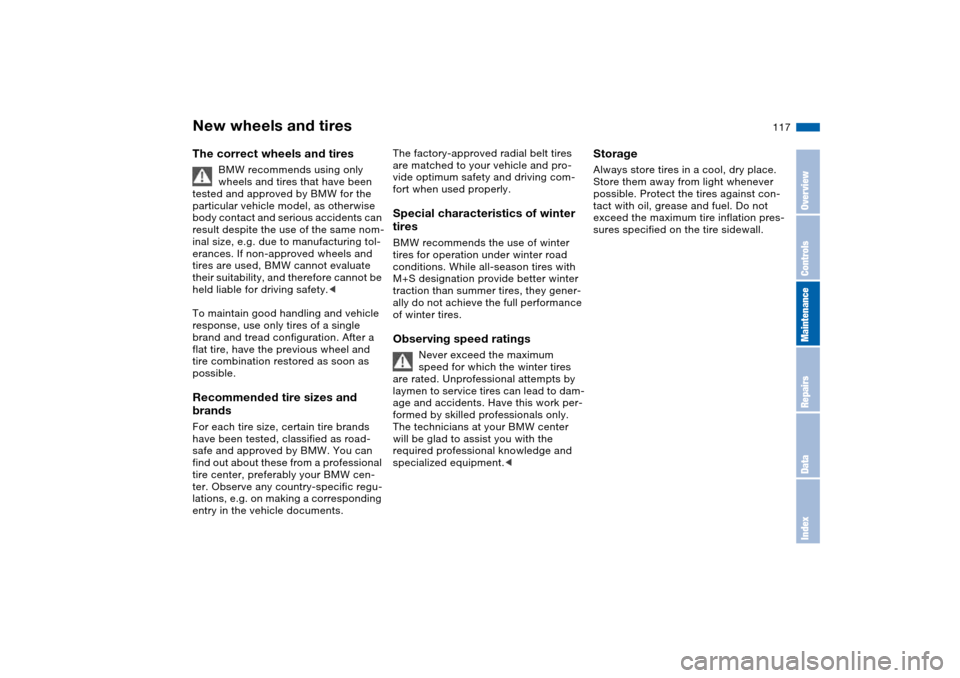
117
The correct wheels and tires
BMW recommends using only
wheels and tires that have been
tested and approved by BMW for the
particular vehicle model, as otherwise
body contact and serious accidents can
result despite the use of the same nom-
inal size, e.g. due to manufacturing tol-
erances. If non-approved wheels and
tires are used, BMW cannot evaluate
their suitability, and therefore cannot be
held liable for driving safety.<
To maintain good handling and vehicle
response, use only tires of a single
brand and tread configuration. After a
flat tire, have the previous wheel and
tire combination restored as soon as
possible.
Recommended tire sizes and
brandsFor each tire size, certain tire brands
have been tested, classified as road-
safe and approved by BMW. You can
find out about these from a professional
tire center, preferably your BMW cen-
ter. Observe any country-specific regu-
lations, e.g. on making a corresponding
entry in the vehicle documents.
The factory-approved radial belt tires
are matched to your vehicle and pro-
vide optimum safety and driving com-
fort when used properly.Special characteristics of winter
tiresBMW recommends the use of winter
tires for operation under winter road
conditions. While all-season tires with
M+S designation provide better winter
traction than summer tires, they gener-
ally do not achieve the full performance
of winter tires.Observing speed ratings
Never exceed the maximum
speed for which the winter tires
are rated. Unprofessional attempts by
laymen to service tires can lead to dam-
age and accidents. Have this work per-
formed by skilled professionals only.
The technicians at your BMW center
will be glad to assist you with the
required professional knowledge and
specialized equipment.<
StorageAlways store tires in a cool, dry place.
Store them away from light whenever
possible. Protect the tires against con-
tact with oil, grease and fuel. Do not
exceed the maximum tire inflation pres-
sures specified on the tire sidewall.
New wheels and tires
OverviewControlsMaintenanceRepairsDataIndex
Page 118 of 170

118
Snow chains*Only certain snow chains have been
tested by BMW and determined and
approved as roadworthy. Consult your
BMW center for more information.
BMW recommends using only these
approved fine-link snow chains. Use
them in pairs on winter tires, but only on
both rear wheels.
Comply with all manufacturer's safety
precautions when mounting the chains.
Do not exceed a maximum speed of
30 mph / 50 km/h when using snow
chains.
After mounting or removing snow
chains, always reinitialize the sequential
M gearbox with Drivelogic, refer to
page 70.
It is not possible to mount snow
chains on tires with 18-inch and
19-inch wheels.
Deactivate the Flat Tire Monitor when
using snow chains. Malfunction warn-
ings and undetected losses in pressure
are a possibility when driving with snow
chains.
When driving with snow chains, it may
be useful to deactivate DSC, refer to
page 83.<
Page 156 of 170
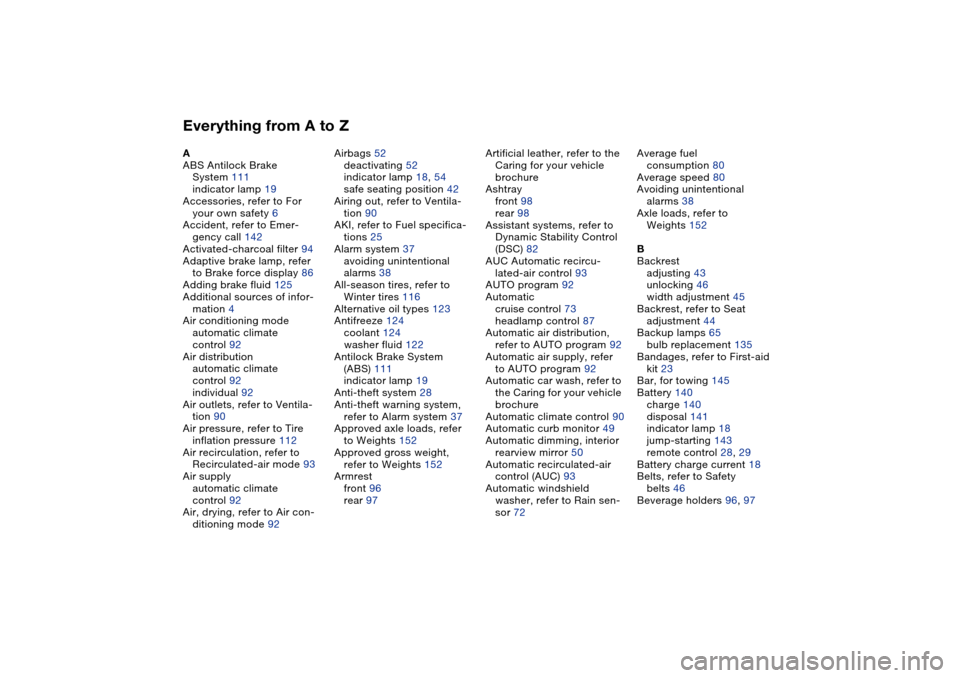
Everything from A to ZA
ABS Antilock Brake
System 111
indicator lamp 19
Accessories, refer to For
your own safety 6
Accident, refer to Emer-
gency call 142
Activated-charcoal filter 94
Adaptive brake lamp, refer
to Brake force display 86
Adding brake fluid 125
Additional sources of infor-
mation 4
Air conditioning mode
automatic climate
control 92
Air distribution
automatic climate
control 92
individual 92
Air outlets, refer to Ventila-
tion 90
Air pressure, refer to Tire
inflation pressure 112
Air recirculation, refer to
Recirculated-air mode 93
Air supply
automatic climate
control 92
Air, drying, refer to Air con-
ditioning mode 92Airbags 52
deactivating 52
indicator lamp 18, 54
safe seating position 42
Airing out, refer to Ventila-
tion 90
AKI, refer to Fuel specifica-
tions 25
Alarm system 37
avoiding unintentional
alarms 38
All-season tires, refer to
Winter tires 116
Alternative oil types 123
Antifreeze 124
coolant 124
washer fluid 122
Antilock Brake System
(ABS) 111
indicator lamp 19
Anti-theft system 28
Anti-theft warning system,
refer to Alarm system 37
Approved axle loads, refer
to Weights 152
Approved gross weight,
refer to Weights 152
Armrest
front 96
rear 97Artificial leather, refer to the
Caring for your vehicle
brochure
Ashtray
front 98
rear 98
Assistant systems, refer to
Dynamic Stability Control
(DSC) 82
AUC Automatic recircu-
lated-air control 93
AUTO program 92
Automatic
cruise control 73
headlamp control 87
Automatic air distribution,
refer to AUTO program 92
Automatic air supply, refer
to AUTO program 92
Automatic car wash, refer to
the Caring for your vehicle
brochure
Automatic climate control 90
Automatic curb monitor 49
Automatic dimming, interior
rearview mirror 50
Automatic recirculated-air
control (AUC) 93
Automatic windshield
washer, refer to Rain sen-
sor 72Average fuel
consumption 80
Average speed 80
Avoiding unintentional
alarms 38
Axle loads, refer to
Weights 152
B
Backrest
adjusting 43
unlocking 46
width adjustment 45
Backrest, refer to Seat
adjustment 44
Backup lamps 65
bulb replacement 135
Bandages, refer to First-aid
kit 23
Bar, for towing 145
Battery 140
charge 140
disposal 141
indicator lamp 18
jump-starting 143
remote control 28, 29
Battery charge current 18
Belts, refer to Safety
belts 46
Beverage holders 96, 97
Page 165 of 170

Everything from A to Z
165
Tires
age 114
breaking in 108
condition 115
damage 115
flat 137
inflation pressure 112
storing 117
tread 115, 116
tread wear indicators,
refer to Tire tread 116
winter tires 116
Tools 132
Torque
engine 150
Tow bar 145
Tow rope 145
Towing 145
Towing eyelet 145
Towing the vehicle 145
Tow-starting 145
Track mode, refer to M
Track mode 82
Track width, refer to Dimen-
sions 151
Transmission
breaking in 108
Transport securing devices,
refer to Securing
cargo 104
Transporting children
safely 55Trap protection
glass sunroof 40
power windows 39
Tread depth, refer to Tire
tread 116
Tread wear indicators in
the tires, refer to Tire
tread 116
Tread wear, tires 116
Trip distance recorder, refer
to Trip odometer 75
Trip meter, refer to Trip
odometer 75
Trip odometer 75
Trunk lid, refer to Luggage
compartment lid 34
Trunk lighting, refer to Lug-
gage compartment light-
ing 34
Turn signal indicator 71
bulb replacement 134
indicator lamp 20
Turn signal indicator, side
bulb replacement 134
Turning circle, refer to
Dimensions 151
TV function, refer to the
Owner's Manual for
Onboard ComputerU
Underbody protection, refer
to the Caring for your vehi-
cle brochure
Units
average fuel
consumption 80
temperature 79
Unlocking
from inside 33
from outside 29, 32
Upshift indicator, refer to
Shift Lights 70
V
Vehicle
battery 140
break-in procedures 108
dimensions 151
leaving the vehicle 64
loading 102
starting 62
washing, refer to the Car-
ing for your vehicle bro-
chure 72
weight 152
Vehicle Memory 59
Vehicle weight 152
Ventilation 90
draft-free 93
Viscosity 123Voice command system 22
microphone 97
Voice control, refer to sepa-
rate Owner's Manual
Volume
luggage compartment 152
W
Warning and indicator
lamps 18
Warning lamp 'Please fas-
ten safety belts' 18
Warning messages 77
Warranty and Service Guide
Booklet 126
Warranty, refer also to sepa-
rate booklet 7
Washer fluid
adding 122, 153
Washer fluid reservoir 122
volume 122
Washer jets, refer to Wind-
shield washer jets 73
Washer/wiper system 72, 73
washer fluid 122
Waste tray, refer to
Ashtray 98
Weights 152
Wheelbase, refer to Dimen-
sions 151
Wheels and tires 112
Wheelslip control DSC 82
OverviewControlsMaintenanceRepairsDataIndex
Page 166 of 170
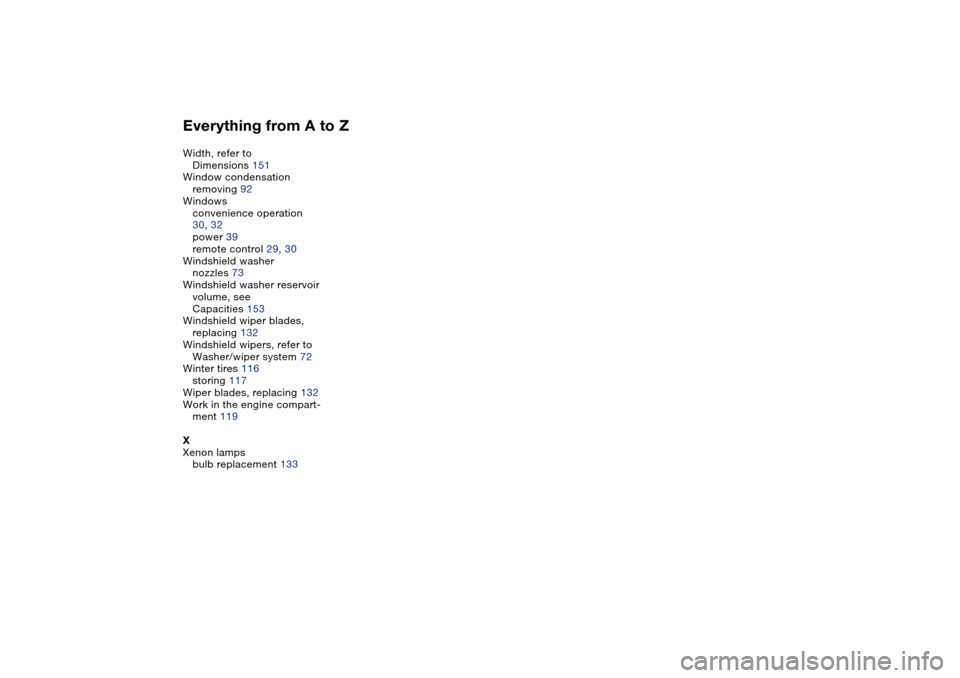
Everything from A to ZWidth, refer to
Dimensions 151
Window condensation
removing 92
Windows
convenience operation
30, 32
power 39
remote control 29, 30
Windshield washer
nozzles 73
Windshield washer reservoir
volume, see
Capacities 153
Windshield wiper blades,
replacing 132
Windshield wipers, refer to
Washer/wiper system 72
Winter tires 116
storing 117
Wiper blades, replacing 132
Work in the engine compart-
ment 119
X
Xenon lamps
bulb replacement 133
Page 169 of 170
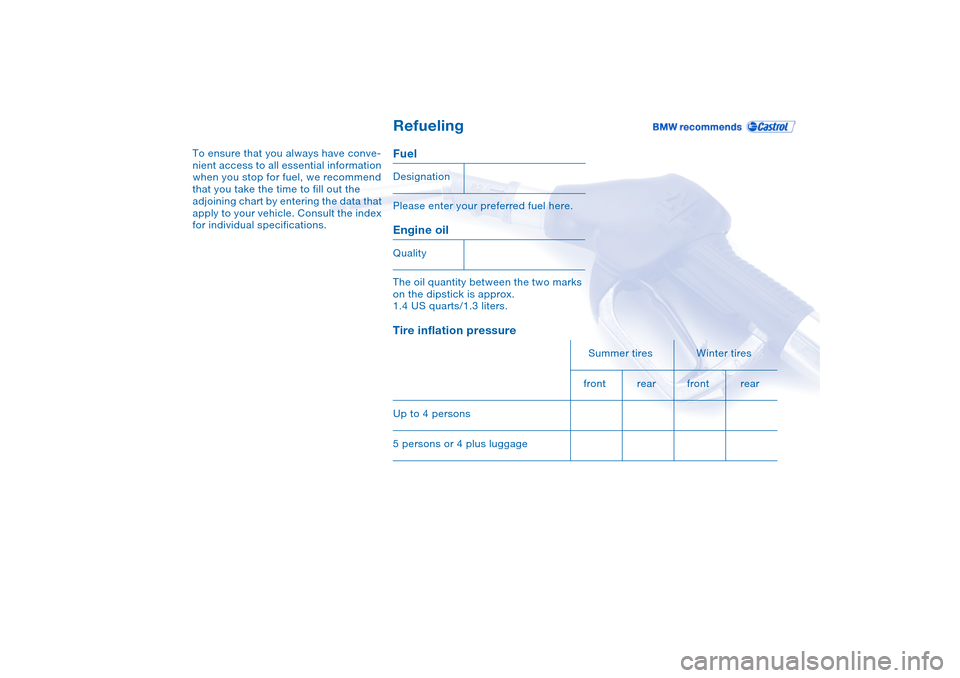
Refueling
To ensure that you always have conve-
nient access to all essential information
when you stop for fuel, we recommend
that you take the time to fill out the
adjoining chart by entering the data that
apply to your vehicle. Consult the index
for individual specifications.
FuelPlease enter your preferred fuel here.Engine oilThe oil quantity between the two marks
on the dipstick is approx.
1.4 US quarts/1.3 liters.Tire inflation pressureDesignation
Quality
Summer tires Winter tires
front rear front rear
Up to 4 persons
5 persons or 4 plus luggage